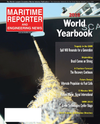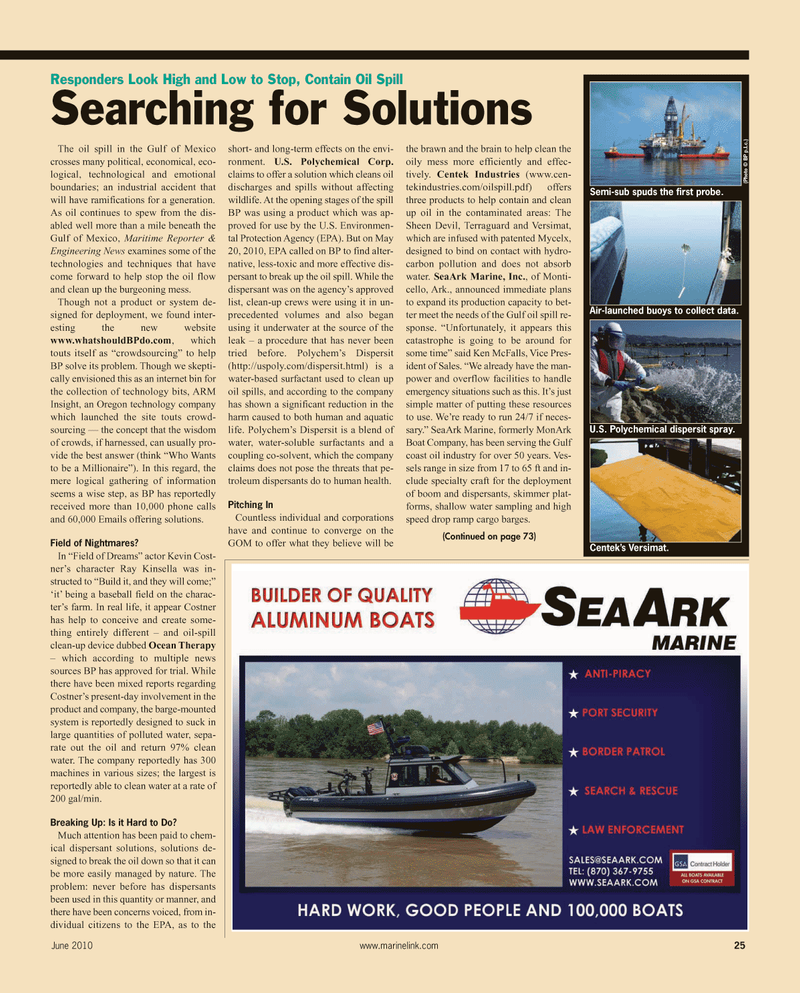
Page 25: of Maritime Reporter Magazine (June 2, 2010)
Read this page in Pdf, Flash or Html5 edition of June 2, 2010 Maritime Reporter Magazine
The oil spill in the Gulf of Mexico crosses many political, economical, eco- logical, technological and emotional boundaries; an industrial accident that will have ramifications for a generation.
As oil continues to spew from the dis- abled well more than a mile beneath the
Gulf of Mexico, Maritime Reporter &
Engineering News examines some of the technologies and techniques that have come forward to help stop the oil flow and clean up the burgeoning mess.
Though not a product or system de- signed for deployment, we found inter- esting the new website www.whatshouldBPdo.com, which touts itself as “crowdsourcing” to help
BP solve its problem. Though we skepti- cally envisioned this as an internet bin for the collection of technology bits, ARM
Insight, an Oregon technology company which launched the site touts crowd- sourcing — the concept that the wisdom of crowds, if harnessed, can usually pro- vide the best answer (think “Who Wants to be a Millionaire”). In this regard, the mere logical gathering of information seems a wise step, as BP has reportedly received more than 10,000 phone calls and 60,000 Emails offering solutions.
Field of Nightmares?
In “Field of Dreams” actor Kevin Cost- ner’s character Ray Kinsella was in- structed to “Build it, and they will come;” ‘it’ being a baseball field on the charac- ter’s farm. In real life, it appear Costner has help to conceive and create some- thing entirely different – and oil-spill clean-up device dubbed Ocean Therapy – which according to multiple news sources BP has approved for trial. While there have been mixed reports regarding
Costner’s present-day involvement in the product and company, the barge-mounted system is reportedly designed to suck in large quantities of polluted water, sepa- rate out the oil and return 97% clean water. The company reportedly has 300 machines in various sizes; the largest is reportedly able to clean water at a rate of 200 gal/min.
Breaking Up: Is it Hard to Do?
Much attention has been paid to chem- ical dispersant solutions, solutions de- signed to break the oil down so that it can be more easily managed by nature. The problem: never before has dispersants been used in this quantity or manner, and there have been concerns voiced, from in- dividual citizens to the EPA, as to the short- and long-term effects on the envi- ronment. U.S. Polychemical Corp. claims to offer a solution which cleans oil discharges and spills without affecting wildlife. At the opening stages of the spill
BP was using a product which was ap- proved for use by the U.S. Environmen- tal Protection Agency (EPA). But on May 20, 2010, EPA called on BP to find alter- native, less-toxic and more effective dis- persant to break up the oil spill. While the dispersant was on the agency’s approved list, clean-up crews were using it in un- precedented volumes and also began using it underwater at the source of the leak – a procedure that has never been tried before. Polychem’s Dispersit (http://uspoly.com/dispersit.html) is a water-based surfactant used to clean up oil spills, and according to the company has shown a significant reduction in the harm caused to both human and aquatic life. Polychem’s Dispersit is a blend of water, water-soluble surfactants and a coupling co-solvent, which the company claims does not pose the threats that pe- troleum dispersants do to human health.
Pitching In
Countless individual and corporations have and continue to converge on the
GOM to offer what they believe will be the brawn and the brain to help clean the oily mess more efficiently and effec- tively. Centek Industries (www.cen- tekindustries.com/oilspill.pdf) offers three products to help contain and clean up oil in the contaminated areas: The
Sheen Devil, Terraguard and Versimat, which are infused with patented Mycelx, designed to bind on contact with hydro- carbon pollution and does not absorb water. SeaArk Marine, Inc., of Monti- cello, Ark., announced immediate plans to expand its production capacity to bet- ter meet the needs of the Gulf oil spill re- sponse. “Unfortunately, it appears this catastrophe is going to be around for some time” said Ken McFalls, Vice Pres- ident of Sales. “We already have the man- power and overflow facilities to handle emergency situations such as this. It’s just simple matter of putting these resources to use. We’re ready to run 24/7 if neces- sary.” SeaArk Marine, formerly MonArk
Boat Company, has been serving the Gulf coast oil industry for over 50 years. Ves- sels range in size from 17 to 65 ft and in- clude specialty craft for the deployment of boom and dispersants, skimmer plat- forms, shallow water sampling and high speed drop ramp cargo barges.
June 2010 www.marinelink.com 25
Responders Look High and Low to Stop, Contain Oil Spill
Searching for Solutions
Air-launched buoys to collect data.
U.S. Polychemical dispersit spray.
Centek’s Versimat.
Semi-sub spuds the first probe. (Photo © BP p.l.c.) (Continued on page 73)

 24
24

 26
26
